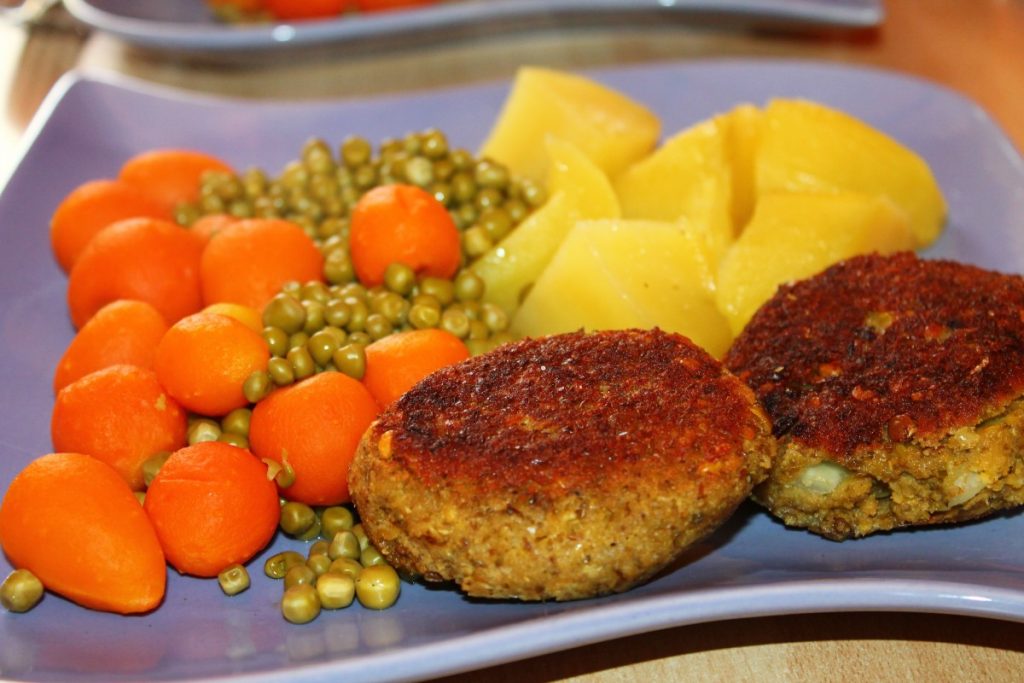Untranslatable Dutch: AVG’tje Posted by Sten on Feb 7, 2020 in Culture, Dutch Language, Dutch Vocabulary
Back with an untranslatable Dutch word! Today we’re actually looking at an abbreviation – AVG‘tje. No, that’s not a cute version of the algemene verordening gegevensbescherming, the EU GDPR legislation that was all over the internet last year, it’s something delicious. So let’s go and take a bite out of it, shall we!
Click here for more untranslatable words
Typisch Nederlands Eten
What’s a typical Dutch dish? Yes, stamppot boerenkool comes to mind, or perhaps kapsalon. But one of the most common Dutch combinations is an AVG’tje – AVG, short for Aardappels, Vlees, Groente (Potatoes, Meat, Vegetables), with the ‘tje at the end because AVG alone wouldn’t sound nonchalant and cute enough for Dutch.
So what does such a “PMV” look like?
Aardappelen (potatoes)
Well, have a look at the picture above. The aardappelen are normally peeled, then boiled for about 20 minutes in salted water and served. Of course, you can make any variation, from aardappelpuree (mashed potatoes) to patat (fries) to aardappelkroketten (potato croquettes). Though that’s a bit too fancy for a good old AVG’tje – gekookte aardappelen with some jus (a brown sauce) are amazing. Appelmoes (applesauce) is also a popular condiment along with the potatoes.
Groente (vegetables)
The groente can vary from rode kool (red cabbage) to spruitjes (brussels sprouts) to a groentemix (vegetable mix). Or perhaps some sperziebonen (green beans)? The choiec is yours! As long as the color is different from vlees and aardappel, it’ll work for an AVG‘tje!
Vlees(vervanger) (meat (substitute))
Lastly, a piece of vlees can’t be missing. Also here, there is a lot of variation. Though the traditional thing is a speklapje (a slice of bacon – but thicker and less fried, so it is more chewy and it has a the pig skin on, too. This is fried until crusty, and is seen as a lekkernij (delicacy). My grandma loves the zwoertjes (pork rinds)! If you want to go fancier, perhaps a biefstuk (steak) or the like, you can. Or go vleesvrij (meatless) and take any vleesvervanger (meat substitutes). There are many very good ones that fit perfectly to an AVG’tje – and the abbreviation doesn’t even have to change!
As you can see, this popular dinner combination is super versatile. It’s easy, quick, and nutritious – and, above all, delicious!
And perhaps a suggestion to you all out there: Why not pick up an already widespread English abbreviation and give it a delicious twist? Having an MVP for dinner sure sounds interesting!
Maak je eigen AVG’tje! (Make your own little MVP!)
Curious how to get started?
There are plenty of recipes out there! Go try it out yourself and be amazed!
Have you made an AVG’tje before? Do you make it in your country? Would you like to try it? Let me know in the comments below!

Build vocabulary, practice pronunciation, and more with Transparent Language Online. Available anytime, anywhere, on any device.





Comments:
Conor:
No doubt you will have heard of ‘meat and two veg’ which seems pretty similar although in the UK, the spuds are usually counted as one of the veg. Wondering if AVG’tje has the same connotation as ‘meat and two veg’ when used as slang!
Love the blog.
Sten:
@Conor Haven’t heard of that, actually! Cool that it exists in the UK too!
Yeah, in the Netherlands, potatoes are so universal that they’re not really counted as the “vegetable”. “Groente” has the word “groen” in it, so it really translates to “greens” more than anything. I think people associate the green stuff more with veg than anything else.
Thanks for the love!
Nikki:
@Conor We must be richer in Australia. We always said meat and three vegs ?
Sten:
@Nikki 3 veg??? :O